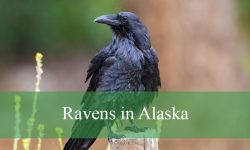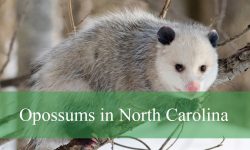As sunlight filters through the towering redwoods and oak canopies of California, a flicker of motion darts along the branches. A fluffy tail flashes silver in the light, a sharp chatter echoes through the forest, and a nimble acrobat bounds effortlessly from limb to limb. These are the squirrels in California — clever, curious, and endlessly busy creatures that have adapted to nearly every environment in the Golden State.
From bustling city parks in Los Angeles to the high Sierra forests and coastal cliffs, squirrels are everywhere — shaping ecosystems, scattering seeds, and surprising scientists with their intelligence and adaptability. But behind those twitching noses and nut-filled cheeks lie secrets few people truly know.
This article uncovers the untold story of California’s squirrels — their species, survival strategies, and fascinating role in nature’s balance.
Meet California’s Squirrels
The Three Main Types
California is home to over a dozen squirrel species, but they generally fall into three main groups: tree squirrels, ground squirrels, and flying squirrels.
The most familiar is the Eastern gray squirrel, introduced from the East Coast but now thriving in urban areas. Native species include the Western gray squirrel (Sciurus griseus), known for its large size and soft silver fur, and the California ground squirrel (Otospermophilus beecheyi), common across grasslands and farmlands.
High in the forests of the Sierra Nevada and coastal ranges lives the Northern flying squirrel (Glaucomys sabrinus), a nocturnal glider that rarely meets human eyes. Each of these species plays a distinct role in California’s varied ecosystems.
Adapting to Every Landscape
One of the most remarkable things about squirrels in California is their adaptability. They thrive from deserts to mountain peaks, adjusting their diets and habits to local conditions.
In the dry Central Valley, California ground squirrels live in elaborate burrows to escape the heat. Along the foggy northern coast, Western gray squirrels leap between redwoods, thriving on acorns and pine seeds. And in urban centers like San Francisco or San Diego, city-dwelling squirrels have learned to forage from picnic tables, trash bins, and backyard feeders with uncanny cleverness.
Their success is a testament to evolution’s flexibility — a story of survival told in every flick of a tail.
Tree Squirrels: The Agile Architects
The Western Gray Squirrel
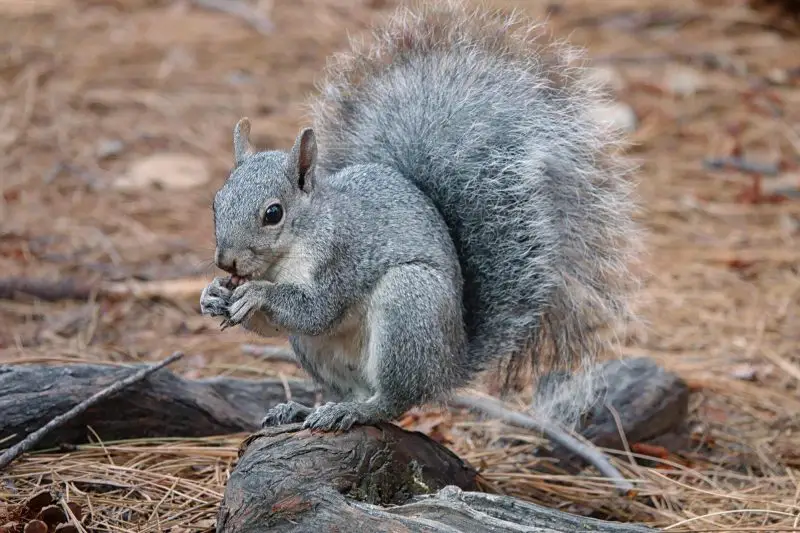
Often called the “silver ghost” of the forest, the Western gray squirrel is California’s largest native tree squirrel. With a long, silvery-gray tail and pure white belly, it moves quietly among oak and pine branches, feeding on acorns, pine cones, and berries.
Unlike the more urban Eastern gray, this species prefers solitude in mature forests, especially along the Sierra Nevada foothills and northern coastal woodlands. Its shy nature makes sightings a treat for hikers exploring California’s mountain trails.
These squirrels are key seed dispersers — their forgotten caches of acorns help regenerate oak forests, shaping the woodlands that define California’s natural heritage.
The Eastern Gray Squirrel: The City Slicker
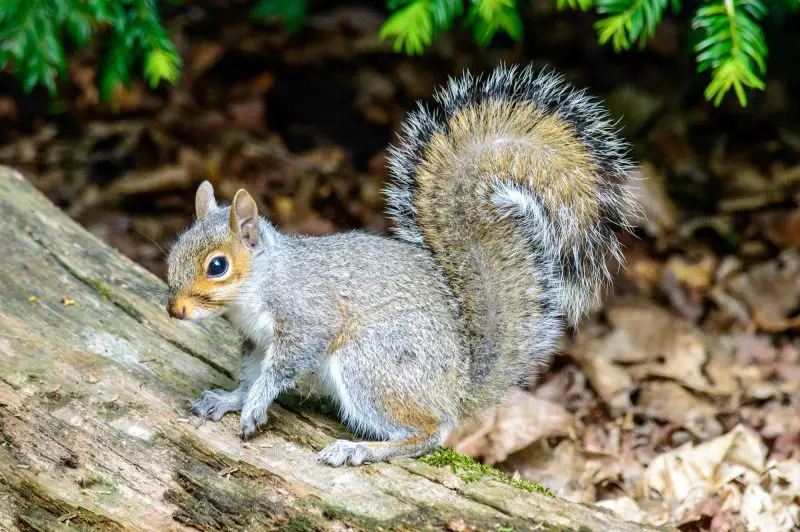
Brought from the East Coast in the early 1900s, the Eastern gray squirrel quickly spread through California’s cities and parks. They’re now the dominant urban squirrel, easily recognized by their gray fur, white belly, and bold personality.
Unlike their native cousins, they’re comfortable around humans, often begging for food or raiding bird feeders. Their adaptability to concrete and chaos has helped them outcompete the Western gray in many urban and suburban areas.
Despite being non-native, their presence illustrates how squirrels — perhaps more than any other small mammal — can thrive in landscapes reshaped by people.
Ground Squirrels: The Burrow Engineers
The California Ground Squirrel
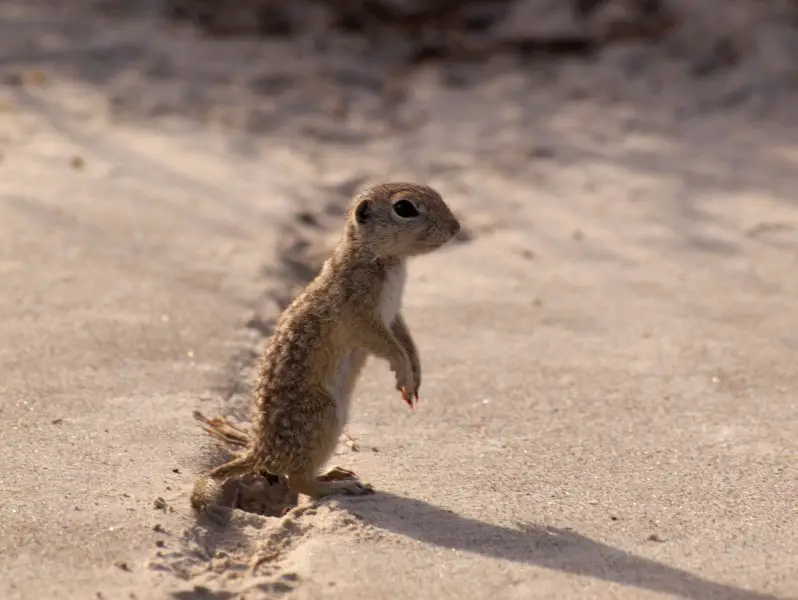
No discussion of squirrels in California is complete without the California ground squirrel, a species as iconic to the state’s grasslands as the coyote or red-tailed hawk. With mottled brown-gray fur, a bushy tail, and bright eyes, it spends most of its life on the ground rather than in trees.
Their burrow systems can stretch several meters underground, with separate chambers for nesting, food storage, and escape routes. These tunnels provide shelter from predators and summer heat — miniature cities built beneath the soil.
Highly social animals, ground squirrels live in colonies where they groom, communicate, and even warn one another of danger using sharp chirps and tail signals. Their complex societies rival those of prairie dogs and other communal mammals.
Masters of Survival
During California’s long dry summers, California ground squirrels survive by entering a state of partial torpor, conserving energy during the hottest hours. In colder mountain regions, some even hibernate through winter.
Their diets include seeds, grasses, nuts, and insects — a balanced omnivory that helps them thrive in changing climates. By feeding on weed seeds and aerating soil through burrowing, they play an important ecological role often overlooked by farmers who see them as pests.
In truth, their digging improves soil structure, enhances water absorption, and provides shelter for other species — nature’s engineers beneath the grass.
Flying Squirrels: The Night Gliders
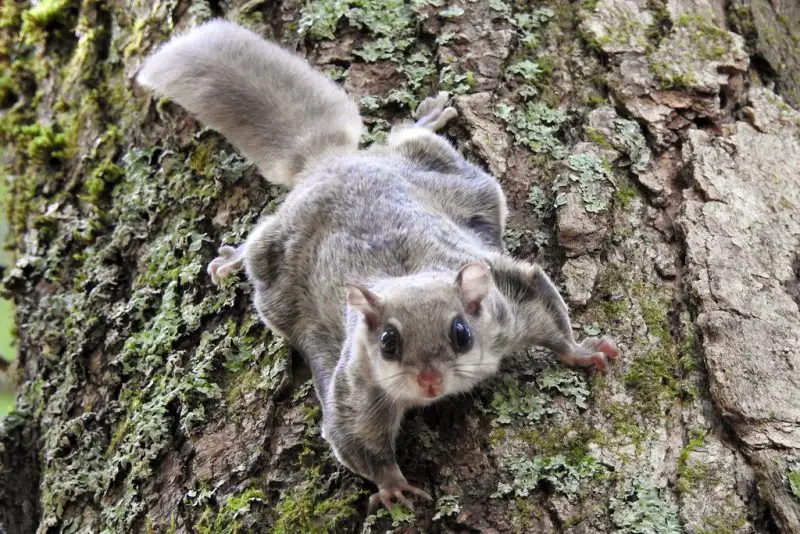
The Hidden Spirits of the Forest
Deep within the forests of northern California, when night falls and moonlight filters through cedar boughs, another kind of squirrel takes to the air. The Northern flying squirrel doesn’t truly fly but glides — stretching a thin membrane of skin between its limbs to soar up to 150 feet from tree to tree.
Nocturnal and secretive, they feed on fungi, lichens, and seeds, playing an essential role in forest ecology by spreading spores that sustain old-growth trees. Their silent flights are rarely seen but vital to maintaining healthy mountain ecosystems.
Flying squirrels are a reminder that even in a state as developed as California, wilderness still holds mysteries unseen by most eyes.
Behavior and Communication
The Language of the Tail
Squirrels don’t just chatter — they communicate through movement. The tail is their primary tool for expression, signaling alarm, curiosity, and even dominance.
A quick flick means alertness; a slow wave shows relaxation. When threatened, squirrels in California twitch their tails rapidly, releasing a burst of scent from glands beneath the tail base — a subtle but powerful warning to others.
These signals allow entire colonies or forest populations to stay synchronized, avoiding predators like hawks, bobcats, and snakes through collective awareness.
Intelligence and Memory
Beneath their playful antics lies serious intelligence. Studies show that squirrels remember the exact locations of hundreds of hidden food caches, using spatial memory and landmarks. They even employ deception, pretending to bury nuts in one place while secretly hiding them elsewhere — an evolutionary response to theft from competitors.
Urban squirrels have been observed solving puzzles, lifting latches, and navigating complex obstacles for food. Their combination of memory, adaptability, and creativity makes them among the most intelligent rodents in North America.
Diet and Feeding Behavior
What They Eat
The diet of California’s squirrels varies widely by habitat and season. In forests, they favor acorns, pine nuts, fungi, and berries. In grasslands, ground squirrels consume seeds, roots, and even insects. Urban squirrels feast on anything edible — from fruit trees to birdseed and discarded snacks.
They’re opportunistic feeders with flexible diets that allow them to survive droughts, fires, and human expansion.
The Art of Stashing
Caching food — hiding nuts and seeds for later — is a defining behavior. Squirrels use both scatter-hoarding (burying individual items across wide areas) and larder-hoarding (storing many in one site).
These caches are critical during dry months and winters, and the leftovers sprout into new plants, turning squirrels into accidental foresters. Without them, oak and pine regeneration in California’s forests would be drastically reduced.
Their messy memory, ironically, keeps the state’s ecosystems alive.
Reproduction and Family Life
Breeding Cycles
Squirrel reproduction is tightly linked to California’s mild climate. Most species breed once or twice yearly, usually in late winter and again in midsummer when food is abundant.
Females nest in hollow trees, burrows, or leafy dens, giving birth to litters of 3–6 blind, hairless young. The mother fiercely guards her nest, grooming and feeding her kits until they’re strong enough to explore the world at around eight weeks old.
By autumn, juveniles are fully independent — practicing leaps, caching nuts, and learning survival skills through play.
A Mother’s Dedication
Among squirrels in California, maternal devotion is remarkable. Ground squirrel mothers defend their burrows with fierce determination, while tree squirrel mothers move their young between multiple nests to protect them from predators or parasites.
In every corner of California’s wild and urban landscapes, squirrel families embody persistence and care — instincts refined by centuries of survival.
Squirrels and California’s Ecosystems
Forest Builders and Seed Planters
Squirrels are often called the gardeners of the forest, and for good reason. Their habit of burying seeds creates natural reforestation. Oaks, pines, and even redwoods owe part of their spread to forgotten squirrel caches.
By scattering acorns far from parent trees, squirrels in California reduce competition among seedlings and help forests recover after fires. Ecologists consider them keystone species — small animals with an outsized impact on landscape renewal.
Prey and Predator Balance
Squirrels are vital to California’s food web, serving as prey for hawks, owls, coyotes, and snakes. Their population stability supports numerous predators, maintaining a balanced ecological cycle.
Even their burrows and abandoned nests provide shelter for insects, reptiles, and small birds — living architecture that supports biodiversity.
Squirrels and Humans in California
Urban Encounters
In cities from Sacramento to San Jose, squirrels have adapted to human rhythms. They dart across sidewalks, raid feeders, and scold pedestrians from tree limbs. While some residents find them mischievous, others enjoy their presence as a lively connection to the wild.
However, human-squirrel coexistence requires balance. Feeding them can lead to dependency or overpopulation, so wildlife experts advise letting them forage naturally. Planting native trees and shrubs is a better way to support healthy populations.
Agricultural Challenges
In agricultural regions, California ground squirrels are sometimes considered pests for digging burrows that damage irrigation lines or eat seedlings. Yet many farmers now recognize their ecological value — their burrows aerate soil, and their presence attracts raptors that naturally control rodent outbreaks.
Integrated pest management programs increasingly favor non-lethal approaches, striking harmony between agriculture and wildlife.
Myths and Misunderstandings
Squirrels and Rabies
One persistent myth claims that squirrels carry rabies. In truth, cases are virtually nonexistent. Squirrels’ small size and strong immune response make them unlikely carriers. Their defensive bites may hurt, but they rarely transmit serious disease.
Are Squirrels Overpopulated?
Population spikes do occur, especially after mild winters and bumper acorn crops, but these fluctuations are part of natural cycles. Predators, food shortages, and environmental pressures eventually restore balance.
Despite their abundance, squirrels remain essential components of California’s ecosystems, not invaders.
Do Squirrels Remember Every Nut?
Not exactly. While their memory is excellent, they often forget some caches — and that forgetfulness sustains forests. What might seem like inefficiency is ecological genius in disguise.
Climate Change and Future Challenges
Adapting to a Warming California
With rising temperatures and increased wildfire frequency, squirrels in California face shifting habitats. Forest squirrels lose acorn sources after burns, while ground squirrels contend with drier soils and shorter growing seasons.
Yet these adaptable creatures persist. Post-fire surveys often show squirrels returning quickly, reestablishing caches and reseeding the forest floor. Their resilience offers hope for California’s recovering landscapes.
Conservation and Coexistence
Most squirrel species in California remain abundant, but habitat fragmentation and vehicle collisions pose risks. The Western gray squirrel, in particular, has declined in some regions due to competition with non-native Eastern grays and habitat loss.
Conservation efforts focus on protecting native oak forests, reducing pesticide use, and preserving wildlife corridors that allow safe movement between fragmented habitats.
Surprising and Little-Known Facts About Squirrels in California
-
Squirrels’ front teeth never stop growing — they wear them down through constant gnawing.
-
The California ground squirrel can resist rattlesnake venom to a degree, an incredible adaptation.
-
Flying squirrels glow pink under ultraviolet light — a mystery still being studied.
-
Tree squirrels rotate their ankles 180 degrees to climb down trees headfirst.
-
A single squirrel can bury thousands of acorns in one season.
-
Squirrels communicate using ultrasonic sounds inaudible to humans.
-
They can survive falls from over 100 feet unharmed.
-
Ground squirrels sunbathe to regulate body temperature.
-
Squirrels have been observed “false caching” to trick potential thieves.
-
Their brain regions for spatial memory grow larger in autumn when caching peaks.
FAQs About Squirrels in California
How many squirrel species live in California?
Over a dozen, including tree, ground, and flying squirrels, each adapted to specific habitats.
Are squirrels active year-round?
Yes, though ground squirrels may hibernate in colder northern or mountain regions.
What do squirrels eat most?
Acorns, seeds, nuts, fruits, fungi, and occasionally insects or eggs.
Are squirrels harmful to trees?
Only occasionally; excessive bark stripping can stress trees, but overall, they aid regeneration.
Can squirrels be tamed or kept as pets?
No. Wild squirrels should remain free — taming them harms their survival skills and is often illegal.
Do squirrels carry diseases?
Very rarely. Proper distance and hygiene make risks minimal.
Why do squirrels bury nuts?
To store food for lean seasons — and in doing so, they unintentionally reforest landscapes.
Are squirrels protected in California?
Native species are protected under state wildlife laws; hunting or harming them requires permits.
How do squirrels survive fires?
They retreat to burrows or flee early. Many return quickly to burned areas, helping forests regrow.
Which squirrel is most common in California cities?
The Eastern gray squirrel, an adaptable non-native species now thriving in urban environments.
Final Thoughts
The squirrels of California are more than playful backyard visitors — they are keystone species, architects of forests, and survivors of the state’s ever-changing environment. From mountain peaks to city parks, they remind us that intelligence and adaptability can turn even the smallest creature into an ecological powerhouse.
Their tireless energy and quiet work — caching seeds, aerating soil, feeding predators — sustain California’s biodiversity in ways few realize. The next time you see a squirrel racing along a fence or disappearing into an oak grove, pause and watch closely. Behind those bright eyes lies the wisdom of survival, written into the story of the Golden State itself.
The truth is simple: squirrels in California are not just survivors — they are the heartbeat of the wild hidden in plain sight.

